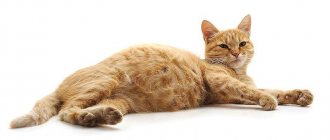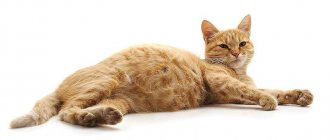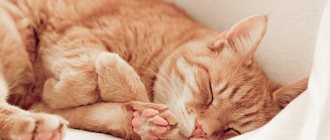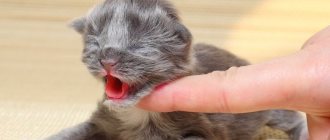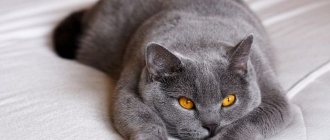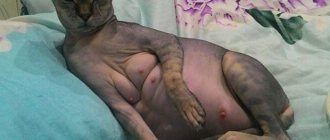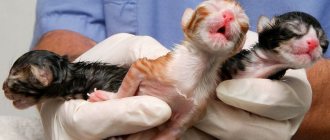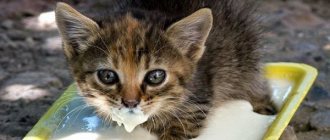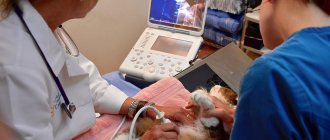Why detect a cat's pregnancy in the early stages?
Despite the fact that a cat's body is designed to survive in the wild, care and monitoring of pregnancy are very important. The sooner the owner finds out that she is pregnant, the more time she will have to prepare for the arrival of the babies.
For your information! The ability to bear kittens occurs at different ages in each breed. For example, British cats are ready for their first pregnancy only after 1 year of life.
It is especially important to monitor the condition of purebred animals (for example, sphinxes, folds). Some breeds may have difficulties during pregnancy and birth. In addition to being monitored by a veterinarian, owners must be able to independently handle the cat during labor if assistance is needed.
It is advisable to immediately find out if your cat is pregnant so that if something happens, you can help her with childbirth.
In ordinary (eg Scottish) cats, pregnancy takes 9 weeks, which averages 62-65 days. Representatives of large breeds (Maine Coon) bear kittens for about 10 weeks, which corresponds to 65-72 days.
What to do if pregnancy is confirmed?
When the animal reaches physiological maturity, the owner is forced to decide whether he wants the pet to bear offspring. If the answer is no, then sterilization will eliminate an unplanned pregnancy. You can also sterilize a pregnant cat, no matter how inhumane it may sound. It is the owner who will be responsible for the offspring of his pet.
If the breeder is ready for the upcoming worries, you should consult a veterinarian. He will determine the pet’s condition and give the necessary recommendations.
Changes in keeping a pregnant cat
A cat's gestation period lasts 9 weeks. During this short period by human standards, she requires special care. What you need to pay attention to:
Features of animal nutrition
The approach to feeding a pregnant cat is different from everyday. From the first weeks, the animal's need for food gradually increases.
Provided that the cat no longer suffers from nausea, the usual portion of food can be increased by 10%. There is also a need for additional food and fluid intake. A pet's diet should under no circumstances be meager. During the period of bearing kittens, she needs much more vitamins and microelements. You should not feed your cat food from the owner's table. Breeders agree that, if possible, it is better to use special food for pregnant women. Only with this approach to nutrition can an animal produce healthy offspring.
Overfeeding can negatively affect birth due to the large mass of kittens.
You should focus on the dry food feeding standards given in the table below:
Serving (g/day) depending on pregnancy period
Source
When can a cat become pregnant?
A cat is ready to become a mother for the first time at the age of 5 to 9 months, but this period may shift. There are many factors that influence an animal's reproductive process. Body size, breed, general health and even the length of daylight hours all matter in one way or another. As a result, the age of a cat for the first pregnancy can vary from 3.5 (that is, pregnancy occurs even in small kittens) to 18 months.
Readiness to mate is expressed by peculiar behavior: the cat becomes very restless, constantly demands attention, may sleep less and eat worse. In addition, a characteristic pose appears when the cat falls on its front paws, arches its lower back, rolls on the floor and purrs or meows invitingly.
There are pathologies with similar symptoms that can be confused with a real pregnancy:
- false pregnancy;
- ascites;
- tumors.
How do these conditions differ from true pregnancy? In case of a false pregnancy, a cat exhibits absolutely all the symptoms, except for one thing – the kittens do not move at the prescribed period. With ascites and tumors, there is nothing but an enlargement of the abdomen from fluid accumulated in the abdominal cavity or the growth of the tumor itself in the abdominal cavity.
Both conditions are considered abnormal in the cat's health and require veterinary intervention. If there are no signs of a normal pregnancy in a cat, you should immediately take it to a veterinary clinic for examination.
When does the need to mate arise?
The animal’s desire to intensively search for a sexual partner appears in February–March. The famous phrase “March cat” has already become a symbol of increased sexuality. The decline in cat demand occurs in the fall.
For the first time such changes occur in a young animal at the age of 8-10 months.
However, since a growing organism is not able to bear a fetus normally, mating of animals can be carried out after the pet reaches the age of 1.5 years. To do this, you will have to miss 1-2 heats. This is especially important for animal breeders to understand. In the pursuit of large incomes, this rule is often ignored. This damages the health of the fluffy.
Cats understand their owners, but their physiological needs come first. And nothing can be done about it.
An important factor for the sexual activity of an animal is the conditions in which the pet is kept.
For normal development, and therefore, the production of healthy offspring, it is necessary to provide nutrition with a full range of vitamins and microelements, depending on the breed, and maintain activity.
The cat is a mystical creature. People have long believed that these unique animals are capable of not only giving their owner warmth and love, but also protecting them from any negativity. When purchasing a fluffy cat, you need to remember that, as she grows up, she will begin to go for walks. Always affectionate and calm, one fine day she will begin to behave very strangely: meow loudly, calling for the cat. But after some time, the “cat concert” will pass, and the pet’s behavior will again be normal. This article will tell you at what age a cat begins to ask a cat, how to understand it and what to do.
Many owners are interested in the question of what time cats start walking and how long this period lasts. Naturally, all animals are individual and each one experiences this moment at a different time. As a rule, the furry creature begins to ask the cat at about 6 months. But no later than 10 months.
There are a number of factors that influence what time a cat starts begging:
Representatives of the cat family reach sexual maturity at 7-9 months. True, in some breeds this happens earlier. During puberty, the pet acquires the ability to produce mature eggs. But this does not mean that from the first heat the animal is ready to conceive. It is necessary for the animal to grow a little more and get stronger.
At what stage can pregnancy be determined?
How to understand that a dog is pregnant: signs in the early stages
You can visually recognize a cat’s pregnancy only by the animal’s changed behavior. A month after fertilization, the sides of the abdomen and swollen nipples become noticeable.
You can find out about pregnancy in the early stages from your veterinarian. In hospital settings, ultrasound is performed starting from the 20th day after fertilization. At 25 days, an analysis is done at the veterinary clinic, and after 26-30 days, the doctor palpates the abdomen to determine the presence of a fetus. Another way is an x-ray, but it can be done starting from the 40th day.
The first signs are below.
Changes in appetite
To answer the question of how to determine if a cat is pregnant, you need to monitor your pet’s behavior. In the first weeks after mating, the animal's appetite rarely decreases. Sometimes vomiting is observed in the morning.
Unfortunately, vomiting can be the cause of many diseases, in particular worms. Therefore, if this sign is present, it is advisable not to delay and take the cat to the veterinarian.
From the middle of pregnancy, the appetite grows rapidly, so during the process of bearing kittens, a cat can gain up to 3 kg.
Changes in behavior
A possible pregnancy can be determined by changes in the animal's character and behavior. At first, the cat behaves slightly aggressively.
From the second half of gestation of kittens, the cat’s behavior changes in the opposite direction. She looks affectionate and gentle, and tries to spend most of her time with her owner.
The cat is very affectionate and loving
Not all cats exhibit characteristic changes in behavior. Some pets behave normally throughout pregnancy. Significant changes are observed at the moment before birth. The expectant mother begins to look for a secluded place, behaves restlessly and prefers to be alone.
Termination of heat
The main sign of pregnancy is the absence of estrus. It is this factor that allows you to determine the exact probability of fertilization.
After the estrus stops, the cat begins to behave calmer, stops showing interest in cats, and does not ask to go for a walk.
Changing the color and size of the nipples
To check for pregnancy, you need to look at the animal's nipples. A few weeks after conception, they swell and change color. The color of the nipples becomes much brighter and takes on a pink-red hue. The color changes most intensely when the cat is in position for the first time.
Important! Swelling of the nipples also occurs during estrus, so this sign alone should not be taken into account.
The first appearance of colostrum occurs a week before birth. The initial composition of the secretions contains a large amount of protein and fats; over time, the amount of substances changes slightly.
The desire for comfort and arrangement of a sleeping place
The less time remains before giving birth, the more the cat begins to fuss. She chooses a comfortable place where the babies will be born in the future. To prevent her from giving birth on her owners’ bed or in another inappropriate place, it is necessary to create a secluded corner for the cat in advance.
In addition to maintaining comfortable conditions, it is necessary:
- ensure complete peace of mind;
- limit the cat’s communication with other animals;
- monitor the cleanliness and hygiene of the animal;
- Provide clean water and balanced food.
Nesting
This symptom is characteristic of late pregnancy. At this moment, the cat begins to prepare for the upcoming birth. She often chooses a suitable place herself, but the owners can help her by providing her with a cozy nest. First of all, it should be cozy, warm and protected from drafts.
In recent days, a pregnant cat begins to look for a secluded corner
Drowsiness and apathy
Signs of a cat's pregnancy often include decreased activity and frequent sleepiness, which are a consequence of hormonal changes. Active and playful cats prefer to sleep most of the day in the first weeks of pregnancy. At this time, they usually have a decreased appetite, due to which the animals are physically unable to be active.
Note! In later stages, the animal’s condition improves, but the cat cannot be playful due to its growing belly.
The birth process
Kittens ready to be born line up to be born in the animal’s two-horned uterus. The birth process is divided into 3 stages:
- The cat feels contractions of the uterus and at the same time the urge to have a bowel movement. The cervix begins to open slightly. Often at this stage the birth plug comes out along with mucous secretions.
- In the second phase, contractions become more intense and painful, the cervix opens completely, preparing to let the kittens move through the birth canal. The cat strains, trying with all her might to “push through” the cubs. This is how a healthy kitten is born with a favorable course of labor. If the amniotic sac has not burst earlier, the baby is born in it. Usually the woman in labor frees the kitten herself by gnawing the shell. But it happens that she leaves the place of birth in fright or gets lost during the first lambing, and then you must come to the rescue by cutting the bladder with sterile scissors so that the baby does not suffocate. The next cub should emerge 15, maximum 40 minutes after the first.
- At the final stage of labor, the placenta is separated from the mother. The cat must eat one of the nursery places - this will help her quickly realize that she is a mother and speed up lactation. Make sure that after each kitten there is an afterbirth. The placenta remaining in the pet’s body can rot, which will lead to severe inflammation and even death of the animal. At the same time, the cat may eat a stillborn or too weak kitten, which is best avoided.
Well, the birth is over. Make sure your pet has given birth to all the kittens by feeling her belly: it should be soft and empty. If you still have doubts, and the cat is in no hurry to feed and caress the cubs, but still shows signs of anxiety, seek advice from a specialist.
You can also contact our site's staff veterinarian, who will respond to them as soon as possible in the comment box below.
When mating has taken place or if the cat has run away from home during estrus, it is important to determine pregnancy as early as possible. The hormonal levels in the animal’s body change, so pregnancy affects the mood, behavior and appearance of the pet. It is often difficult for inexperienced owners to understand at home whether their cat is expecting a replenishment. Timely detection of signs will allow the cat to receive the necessary assistance for a successful birth in the future.
- Show all
What changes occur before childbirth?
Cats mature at 6–7 months. It is during this period or a little later that they have their first heat. However, the body needs a few more months to fully develop. Mating is carried out only for the third time of sexual heat. The optimal age is about one and a half years.
The cat is looked for in advance, especially during breeding. The female and male are preliminarily checked for the presence of infections, viruses, and anomalies. Two weeks before mating, preventive deworming is carried out.
The cat is not washed immediately before mating. Water and cosmetics destroy the natural odor that attracts the male. The meeting is scheduled for 3–5 days from the start of estrus. This is the most productive period when the probability of fertilization is highest. To do this, they usually choose “male” territory.
The fact that a cat is ready for sexual intercourse upon meeting is indicated by flirting with a sexual partner. Owners should be on alert, because animals can be injured during mating games.
The duration of one sexual act is 30 seconds. At the same time, the cat purrs, and the partner responds with a loud cry. During coitus, an egg is released from the ovaries, and fertilization occurs within 24 hours. Mating can be repeated 5–8 times. When the process is over, the cat begins to roll on its back, and the cat moves away and licks itself to the side.
Mating in cats
Sometimes the cat is left with a partner
It is very important for the owner to know the due date, because it is unknown how this process will go, and it may be necessary to provide assistance to the pet. You can find out when this period is approaching using the following signs:
- About 3 days before the onset of birth, the cat begins to look for a secluded corner, she looks for a suitable place, and begins to build a nest. To prevent this process from happening on your bed, it is best to prepare for it in advance. You can offer her a box covered with a warm cloth and a sheet on top.
- The cat's nipples sharply increase in size, from which colostrum is secreted. Mucus discharge is observed from the genitals.
- The temperature drops sharply by about 1 degree and can reach 37 degrees.
- 10 hours before the birth of the offspring, the pet hides in its nest. There is no need to disturb her; you can help at this stage by providing fresh water.
The decision has been made, now we need to wait for the right moment. In young females, sexual desire is often weak. But each time the desire to become a mother will become stronger, and the pet will demonstrate it more and more often. Under optimal conditions, a cat can give birth twice a year, but she can only be bred if she is in good physical shape.
When to urgently contact a veterinarian
Any condition of the cat that attracts the owner’s attention and seems unusual should be the reason for a consultation or visit to the veterinarian. Especially when one of the following manifestations is noted:
- The appearance of any unexplained protrusions between the nipples that were not there before. This is especially true for the place between the penultimate and last pair.
- Discharge of blood clots or just blood from the genitals.
- Excessive anxiety of a cat, when it seems that the animal cannot find a place for itself: it will lie down, get up, try to lie down again, get up again.
- The appetite completely disappears, the pet refuses to drink, there is apathy, weakness, and lack of initiative in relation to what is happening around.
- Towards the end of pregnancy, the abdomen acquires unusual, irregular shapes and outlines, becomes barrel-shaped hard, and when lightly tapping the abdominal wall with your fingers, a dull sound is heard. The loop is swollen and very red.
- There are either no training contractions, or they are very weak, and the uterus is unchanged, taking into account the fact that dilatation should already occur.
- There was a miscarriage, rapid labor began, and bleeding began.
- Abdominal growth is observed without other signs of pregnancy and fetal movements.
How to tell if your cat is late in pregnancy
How to understand that a cat loves you - signs of your pet's feelings
How to understand that a cat is pregnant and in late stages:
- the presence of embryos in the abdomen is determined by palpation;
- nipples swell and change color;
- Appetite improves dramatically, and taste preferences may also change;
- the cat looks fatter as the belly is rounded on the sides;
- in the later stages, the movement of the babies is felt.
Signs of approaching labor
So, you have already purchased and prepared everything you need, all you have to do is wait for the birth to begin. And here the question arises again: how to understand that a cat is giving birth; signs of the end of pregnancy seem to be obvious, but an inexperienced owner needs additional information in order to have time to come to the pet’s aid at the crucial moment.
Signs that a cat is about to give birth are:
- the animal shows strong anxiety, meows loudly, looks for a comfortable, often hidden place to relieve itself of the burden;
- the mammary glands greatly increase in size, the skin around the nipples dries and peels;
- 24 hours before lambing, the pet experiences lactation;
- body temperature drops to 37 degrees and below;
- on the day of lambing, the pet completely loses interest in food;
- a few hours before lambing, the cat begins to bend its back frequently;
- the animal licks the genitals, from which a malicious odor often emanates (sometimes you can notice the release of the birth plug, which is a mucous clot - transparent or having a pinkish, yellowish and even greenish tint, but usually the animal “tips up” the plug, which comes out in parts, along with the secretions ).
The removal of the plug and an actively “moving” belly indicate that the pet is about to begin or has already begun contractions.
General information
On average, a cat's pregnancy lasts 55-70 days; the larger the breed, the longer the cat bears kittens. But the problem of determining whether conception has taken place is the same for all purebred and outbred cats - until the 25th day you will definitely not be able to check the presence of fetuses in the uterus. Yes, there are signs of successful conception that apply after a planned mating, but all of them can also be the consequences of a false pregnancy. And it is especially difficult to determine whether a cat is pregnant or not if the animal has free access to the street or even lives in the local area without constant supervision.
How to distinguish a false pregnancy from a real one
In some cases, indoor and outdoor cats suffer from false pregnancy. The causes of the pathology can be:
- sudden stress or emotional overstrain in the pet;
- mating with a sick cat;
- improper functioning of hormonal levels;
- being near a pregnant cat.
How to understand that a dog is dying: signs of impending death
Only a veterinarian can check for a false form of pregnancy. Using an ultrasound, the cat's uterus is examined. The absence of kittens in the womb indicates the development of pathologies in the pet’s body. Treatment is prescribed depending on the cause and form of the disease. Therapy is often carried out using hormonal agents.
Important! It is necessary to understand that false pregnancy poses a serious threat to the cat’s life. Therefore, ignoring the problem can lead to serious consequences.
An animal's pregnancy may be false.
Video “Cats. Life before birth"
This video will talk about the conception and birth of kittens.
Sorry, there are no surveys available at this time.
Animal language is different from human language. By their actions, changes in habitual behavior, hissing, groaning, they signal a problem. How to understand that a cat wants a cat? How not to confuse her changed behavior with a disease?
The care and love of the owners should come first when it comes to such a simple and complex (at the same time) issue as mating. Only understanding what the animal wants to say in its own language will ensure peace and comfort in the family where the pet lives.
If Western cats need to go for a walk once every 3 months, Eastern beauties need to do this more often
. When purchasing an animal, you should take into account such nuances. Oriental cats are famous for their temperament, while representatives of European and American breeds are calmer.
The attitude of the owners towards the animal, understanding its problems and physiology is of great importance. Animal behavior should not be assessed from the point of view of human morality. Cats are guided by natural instincts, unlike people. Changes in a pet's habitual behavior can be caused by various reasons.
. To find out exactly which one you should contact your veterinarian.
Signs that allow you to determine that a cat wants a cat
Long-term observations of the behavior of fluffy beauties have made it possible to accurately determine whether a cat wants a cat based on a number of primary signs. :
- Loss of appetite;
- The cat moves its tail to the side;
- Raises the back of the body;
- Frequent urge to urinate;
- Enlargement of genital organs;
- Discharge appears;
- The fluffies begin to scream, calling their partner to mate.
In addition, increased aggressiveness or, on the contrary, affection will help you find out that a cat wants a cat. For caring owners, a pet's heat is not a significant problem. If measures are taken in a timely manner, the animal will be calm and the owner will be able to sleep at night, and not be nervous because of the pet’s anxiety.
In order to understand what exactly your pet wants, you need to observe its behavior and study the animal’s habits well.
In order not to feel inconvenience, you need to immediately, as soon as the estrus period begins, give the animal medications that calm your pet’s instincts.
Therefore, it is so important to notice changes in behavior in time. As soon as a sign is detected that the cat wants a cat, medication should be administered immediately.
Preparing for childbirth
Owners must prepare for childbirth and create comfortable conditions for her. Within a week, a structure is installed in which the woman in labor will hide. A box with a low side, a bed, etc. is suitable. The area should be large so that the mother and kittens do not feel crowded. You should also ensure that people have access to this box in case assistance is needed.
For childbirth, you need to prepare a first aid kit
In this case, the veterinary first aid kit should contain the following items:
- disposable and flannel diapers (used for lining and covering kittens);
- pieces of textile the size of a handkerchief for wiping (gauze is not suitable);
- chlorhexidine or alcohol for cleaning tools and hands;
- the smallest size syringe for removing fluid from the noses of kittens;
- to lubricate the loop during difficult labor - sterile petroleum jelly and a pipette;
- brilliant green for lubricating the umbilical cord;
- cotton buds;
- a heating pad for the bed of newborn kittens;
- scissors washed with boiling water with blades rounded at the ends;
- scales.
The following medications are included in the first aid kit:
- calcium gluconate in solution for injection - stimulates contractions;
- Mastomethrin - stops inflammation, disinfects;
- Travmatin - relieves pain during childbirth, regulates the strength of contractions.
Procreation is a basic instinct in animals
Pregnancy is a difficult period in the life of a female, including cats. It largely depends on the person how the gestation of kittens will go and whether the offspring will be healthy.
Rules for caring for newborn kittens
Diagnosis of pregnancy
To be sure of your cat's position, the veterinary clinic offers the following procedures.
Ultrasound (ultrasound sonography)
It is not always easy to determine whether an outdoor cat or an indoor cat is pregnant based on one sign. Difficulties often arise in the early stages, when even the veterinarian cannot confirm the pet’s position.
Diagnosis in the clinic is carried out from the 20th day after conception using ultrasound therapy. Before the procedure, you must consult with a veterinarian in advance and find out how to prepare the animal for examination.
For your information! Ultrasound sonography allows you to establish not only the fact of pregnancy, but also find out the number of fetuses in the uterus, as well as identify pathological abnormalities. A cat examination does not take much time; the ultrasound procedure is safe for the animal and future kittens.
After diagnosis, the doctor will give the owner step-by-step instructions for caring for the cat before and after birth.
Ultrasound examination is by far the most common procedure, which gives 100% results in a few minutes.
Feeling the abdomen (palpation)
For palpation, the animal should be taken to a veterinarian, since independent palpation can harm the animal and small kittens.
The cat on the veterinary table must be kept in a standing position, it should not lie down. The doctor places his hands on both sides of the abdomen and gently palpates the area down to the lumbar region. In the early stages, only small compactions in the uterus can be felt, but in later stages, individual fruits are already noticeable.
Note! To understand that the animal is in position, an experienced doctor only needs a couple of minutes.
X-ray
X-ray is considered the most harmful method of examination. It was used before the advent of ultrasound. In the early stages, the procedure does not give the desired result, so it must be used in the last weeks. It is impossible to determine the presence of pregnancy in this way, but you can determine the exact number of kittens.
Today, X-rays are used extremely rarely when ultrasound does not give proper results.
Lab tests
This diagnosis is carried out in a clinic, where venous blood and urine are taken from the cat. During pregnancy, processes occur in the animal’s body that change hormonal levels and release special substances. As a result, biochemical analysis shows a complete physiological picture and confirms fertilization.
For your information! In cats, the hormone responsible for pregnancy is called relaxin. This is what is detected as a result of rapid tests. It is recommended to conduct research starting from the 26th day after mating. It is during this period that the active formation of the placenta and the production of hormones occur.
Having learned that a cat is pregnant, you need to make every effort so that she gives birth to healthy babies without consequences for herself.
This test can also be performed to determine a false pregnancy. In this case, the analysis shows the absence of the necessary hormone in the blood. The advantage of laboratory tests is a quick result, which is known within 10-15 minutes.
When planning to breed an animal, every owner should be prepared for a quick replenishment. To eliminate problems and provide your cat with maximum comfort, you need to know the main signs of successful conception. In this way, the owner can help the pet bear healthy kittens, as well as prepare the cat for the upcoming birth. It is also important to visit a veterinarian in a timely manner, who will help determine the number of fetuses, as well as identify deviations.
How to determine if your pet is pregnant?
If you suspect that the cat is in an interesting position, then you should pay attention to changes in its behavior, as well as its appearance. An exciting period begins in the life of the fluffy beauty and her admirers, which, with proper care, will not cause much trouble. The first signs of a cat's pregnancy are subtle changes. So how can you understand that a cat is pregnant?
At home
At home, recognizing a pet’s pregnancy in the early stages is a difficult task. A pregnancy test for cats could come to the rescue. Today, a test to detect the onset of fertilization in cats exists, but so far only in European veterinary pharmacies. A rapid test shows the presence of relaxin (a mammalian and human hormone associated with pregnancy) in the blood plasma. However, in addition to the test, there are signs that will also help you draw the right conclusion. How to understand that a cat is pregnant? Let's take a closer look.
By external signs
External early signs of pregnancy in a cat:
According to behavioral characteristics
Immediately after mating, it is difficult to find out whether conception has occurred, since outwardly her behavior remains the same. How to understand and check whether fertilization has occurred or not?
As the gestational age increases, the behavior of the expectant mother will change; the following signs can be observed:
As your pregnancy progresses, your appetite returns and even increases. This circumstance is due to the fact that when carrying kittens, the expectant mother needs more calories and nutrients.
The owner should treat his pet with attention, then the onset of pregnancy will not come as a surprise to him and he will be able to respond in time to a new period in the life of his pet. Early pregnancy symptoms will not go unnoticed.
In a veterinary clinic
Is it necessary to contact a veterinary clinic for an examination if the owner is completely sure that the pet is expecting kittens? Firstly, visiting the clinic will help rule out a false pregnancy. Secondly, it is necessary to exclude possible pathologies in the development of the ongoing pregnancy. Thirdly, in a veterinary clinic, during an ultrasound, you can determine the number of expected kittens (possible only 40 days after pregnancy). A study to confirm pregnancy is recommended to be carried out 3-4 weeks after conception supposedly occurred.
In addition to ultrasound examination, the doctor is already able to detect the pregnancy of the animal by palpation on the 20th day after fertilization. Palpation can only be done by an experienced specialist, since incorrectly performed manipulation can lead to miscarriage. There is also a possibility of mistaking another formation (tumor, cyst) for the fetus.
Caring for a pregnant cat
Veterinarians say that caring for a pregnant cat should be approximately the same as caring for a woman carrying a child. This is a serious burden on the body, which can fail at any moment. Owners must:
- visit a veterinary clinic and undergo an examination;
- keep the tray clean;
- finds time to play and communicate with the pet;
- Maintain body hygiene by brushing often;
- take care of the absence of fleas (a safe remedy will be recommended by a doctor).
Pregnancy is a reason to visit a veterinarian.
If your cat needs to be bathed, it is better to consult a doctor first. In this case, use only special shampoo for cats. Then the animal is moved to a warm corner without drafts.
During pregnancy, the cat’s habitat must be made as comfortable and safe as possible - remove high scratching posts and complexes where she likes to play.
Nutritional needs change throughout pregnancy. The first two weeks, when appetite increases slightly, the daily portion is increased by 10%. In this case, the entire volume of food is divided not into 2 meals, as usual, but into 4–5. From 3 to 7 weeks, the amount of feed is doubled from the original. Over the last fortnight, my appetite has decreased slightly as the fruits put pressure on my internal organs.
Pregnant cats have a good appetite.
The diet should not contain foods from the human table, especially those containing chemical additives - chips, sausages, smoked meats, including fish. This is harmful to all domestic animals, and their benefits for humans are questionable.
Nomes for feeding cats
Cat breeders have not yet come to a consensus on which food is better - industrial or natural. But they agree on one thing: if it is ready-made food, then it must be the highest quality available. Switching to a different type of diet will do more harm than good.
Cat breeders never tire of arguing about which food is best.
Royal Canin Queen
Acana Pacifica
Bozita
Josera Minette for kittens and nursing cats
These brands fall into the holistic and premium categories. They contain a sufficient amount of fat, protein, and amino acids to provide the expectant mother with energy for pregnancy and strengthen her immune system.
Kitten food is one of the options for complete nutrition for a pregnant or lactating cat.
In addition to the main diet, from time to time you can pamper your cat with natural products - meat, cottage cheese, yogurt. But then this is a delicacy, not the main food.
Many sources on cat nutrition note that it is not worth giving additional vitamins and minerals, since everything necessary is included in the product. Only a veterinarian can determine the possible need for supplements.
We invite you to familiarize yourself with the process of giving birth to a British Shorthair cat.
Natural nutrition
Breeders pay special attention to the natural nutrition of the cat.
Table 2. Qualitative composition of the diet of a pregnant cat.
| Name | Quantity, % |
| Squirrels | 25 |
| Carbohydrates | 25 |
| Fats | 12 |
| Cellulose | 2-3 |
| Minerals | 6 |
| Water | 29-30 |
Cats usually refuse plant foods. But if you grind it in a blender to a puree and mix it with meat products, then its taste buds can be deceived. You should not cut food into cubes, since only meat pieces will be selected from the plate.
A cat needs the following products:
- dietary meat - chicken, veal, beef (can be raw, but only fresh and high quality);
- sometimes - boiled fish;
- eggs - 2 pcs. in Week;
- low-fat dairy group - cottage cheese, yogurt, sour cream, cream, yogurt;
- cereals - oatmeal, rice, buckwheat;
- jelly, boiled cartilage.
Natural products are necessary for a pregnant cat.
For constipation, the cat is given beets and the amount of vegetable fat is increased. But they are excluded or the dose is reduced after the condition has stabilized.
Breeders recommend giving cats an infusion of raspberry leaves. It is prepared from a tablespoon of dry raw materials and a glass of boiling water, left for 15 minutes and filtered. Give a tablespoon 2 times a day from the beginning to the end of pregnancy. This will help bear healthy offspring and simplify the birth process.
In the second half of pregnancy, pre-scalded nettle leaves are added to the drink. These greens promote milk production.
Nettle decoction increases the amount of breast milk
It is necessary to ensure the presence in the diet of vitamins A, D, E, B1, B6, B1, as well as calcium, phosphorus, iron, iodine. Taurine, a sulfur-containing amino acid, is extremely important. If the diet is prepared correctly and is not monotonous, the body receives most of these elements from food. But with an unbalanced diet, vitamin preparations with the listed substances are necessary.
The following brands offer vitamin complexes for pregnant cats:
- Beaphar (Top 10 Cat, Salvical, Irish Cal);
- Brewers Yeast 8 in 1;
- Anivital FeliImmun and others.
Vitamin preparations will provide vital elements.
In cats, the opportunity for fertilization appears after the onset of puberty. For the first 6 months, the cat is considered a kitten, and you don’t have to think about pregnancy yet. But in order to further determine a cat’s pregnancy and its timing, you need to become familiar with the concept of estrus in an animal.
A cat's heat is the beginning of puberty.
A cat's heat is the onset of puberty, therefore the period when a cat can become pregnant for the first time. For the owner, this will be a signal about the animal’s ability to fertilize after mating with a cat.
Some features of the onset and course of pregnancy:
- During the year, a cat may come into heat 2-3 times;
- during the period of heat, the pet changes greatly in behavior: it falls to the floor and begins to rub its stomach and back, while meowing without stopping, it can rub against people, sometimes it makes marks around the house;
During the period of estrus, your pet changes a lot in behavior
- at the beginning of estrus, days 1 and 2, the cat loses its appetite, meowing becomes loud and intense, however, when meeting a cat these days, the cat may not let him near her, but after the first days of estrus, the cat will be ready for mating;
- It is quite rare to see a pregnant cat after the start of her first heat; fertilization usually occurs as a result of several meetings with the opposite sex;
If the owner has a need to sterilize a pet, then it should be remembered that this procedure is best carried out in a cat after pregnancy, first or secondary, it does not matter, the main thing is to know how to correctly determine the moment of puberty and only then contact a specialist.
The diet should not contain foods from the human table, especially those containing chemical additives - chips, sausages, smoked meats, including fish. This is harmful to all domestic animals, and their benefits for humans are questionable.
Pregnancy is a test for a cat’s body. Since all vital organs work in an intensive mode, the animal requires special care and attention. Favorable conditions play a big role in the course and outcome of the condition.
The cat should be kept in a spacious, well-ventilated room without drafts at a comfortable temperature. High humidity and dark lighting are unacceptable.
You should ensure that your cat does not climb onto high furniture, as a fall or awkward landing can lead to serious consequences.
In the later stages, you should help the cat with hygiene, since the large size of the abdomen does not allow the cat to carry out the necessary toileting of the genitals and fur.
What to feed
The general principles of feeding a pregnant cat include following some rules:
- The diet should consist of high-quality feed, rich in all necessary substances.
- It is recommended to provide easily digestible food.
- A pregnant cat requires more frequent feeding. By the second trimester, the daily norm increases by about 50%.
- In the later stages, you should resort to fractional meals 6 times a day.
- It is important to regularly check the presence of water in the drinking bowl. Dehydration leads to abortion, which can cause the death of the cat.
How long is the gestation period in cats?
An important question for the owner is how long a cat’s pregnancy lasts. The average length of pregnancy for a cat is 59 days. However, the gestational age of a cat largely depends on the age of the expectant mother, breed, and individual characteristics. The duration of a cat's pregnancy can be 55–62 days.
The first thing to remember is the time from which pregnancy begins - from the moment of mating and fertilization and at the end of this period with childbirth. The average gestation period for kittens ranges from 62 to 68 days. In cases of premature birth, kittens appear dead.
But this does not apply to all cat breeds; there have been cases where Siamese representatives gave birth to offspring on the 71st day of pregnancy, and the kittens were alive and completely healthy.
A typical cat pregnancy lasts 9 weeks - 55 to 63 days. This period also varies depending on the breed and number of kittens. For example, in cats of Siamese and Oriental breeds, pregnancy sometimes lasts longer than 9 weeks. Multiple pregnancies often lead to a shorter term.
For those planning to breed kittens, it is interesting to know how many pregnancies cats can have per year. Domestic cats are capable of bearing offspring up to three times a year, but this, of course, is a lot of stress for their body. According to veterinarians, it is advisable for a cat to give birth to kittens no more than once a year.
What lessons should be learned in order to prevent unnecessary problems?
We can summarize by saying that, unlike humans, the need to reproduce in animals is an instinct. We can say that they simply have no choice and no concept of “I want” or “I don’t want.” In general, the owners bear full responsibility for their pets. To avoid surprises in the form of a bunch of little fluffy lumps, it is worth taking care of such problems as early as possible. A competent, knowledgeable veterinarian will tell you what to do. Sterilization will help relieve a cat from labor pains. A properly performed operation will save you from many problems, both for owners and furry pets.
On average, pregnancy in cats lasts 65 days (plus or minus 5 days). This period usually guarantees the birth of healthy kittens. But how to know that a cat is giving birth - not every person knows the signs of this event. Many inexperienced owners begin to worry about the upcoming event as soon as they notice that their pet is pregnant. The owner of a cat who is about to give birth for the first time experiences special experiences. And the pet itself often shows anxiety. And I must say: not in vain.
But don't worry too much. You will have enough time to become familiar with the cat's behavior during this period and prepare the necessary supplies for giving birth at home. First, let's try to understand what signs can be used to guess that a cat is pregnant. It will be easiest to recognize an “interesting position” and calculate the date of fertilization if the mating was planned, and you know from what point to keep a record of the pregnancy, which is conventionally divided into three stages with characteristics characteristic of each.
A cat can become pregnant for the first time at the age of six months, when the first heat usually appears. But most veterinarians believe that only a strong female who is at least 12 months old can bear healthy kittens. Pregnancy occurs in 3 stages:
After mating, the cat's genital swelling is visible, but this does not mean that she is fertilized. The first signs will clearly appear from the 3rd week:
- the pet becomes lethargic, eats poorly, moves little, sleeps more;
- within 2-3 days she vomits repeatedly;
- nipples enlarge and acquire a bright pink color or, conversely, become lighter;
- When palpating the cat's genitals, the veterinarian notices an enlarged uterus.
During the middle period of pregnancy, the animal noticeably gains weight as the fetus actively develops. By the 6th week, the amount of amniotic fluid increases and the kittens begin to move for the first time. By stroking your pet's belly, you can carefully “feel” the future children.
At 7-9 weeks, the cat’s excitement intensifies, she fussily rushes around the apartment in search of a future “nest”. Kittens move actively, which is especially noticeable in a sleeping cat. The animal restlessly licks its genitals.
Cat behavior just before labor begins
If the initial period of pregnancy is missed due to the owner’s carelessness, you should know how to determine the onset of labor in a cat.
Most cats do not require assistance with their kittens.
A few days before lambing, the animal may completely stop eating, and its behavior becomes quite nervous. During this period, you can notice how the stomach drops, water flows out, the shade of which is gray with a red admixture. Labor can last about a day.
Most cats do not require assistance when giving birth to kittens; they are able to gnaw the umbilical cord themselves using their teeth. However, not all animals are the same, which is why some cats ask their owners for help.
Some cats will still need help, and during pregnancy you should pay more careful attention to your pet
During the postpartum period, the animal should be helped to recover by showing care. It is worth treating the mammary glands to prevent bacteria from entering.
Optimal age for mating
Puberty in cats occurs between 7 and 9 months of the animal's first year of life. The onset of this period is difficult to miss. The pet exhibits new behavioral traits:
- Slowly walking on half-bent legs;
- Long and persistent meow;
- Constant demand for affection from owners;
- Purring accompanied by rubbing against various objects.
At the same time, the first estrus appears in females. How quickly this happens, and how regularly it will happen in the future, directly depends on a number of factors, primarily on the breed. This phenomenon is accompanied by increased sexual arousal. By this indicator you can learn about sexual maturity and readiness for reproduction.
With the onset of heat, the cat begins to lick itself frequently and urinates profusely.
You can recognize this by interruptions in appetite. During the period of heat, the cat becomes more affectionate; she rolls and wriggles on the floor for a long time. At any opportune moment she tries to sneak out into the street.
. It happens that some individuals during this period show aggression that is unusual for them. It will go away on its own.
The frequency of estrus occurs approximately every three weeks throughout the year. Sexual activity is observed year-round, but heightened desire can be observed in the period from February to March.
However, you should not organize mating before the animal is one year old. Early fertilization threatens the deflection of the spine and the threat of difficult childbirth.
How pregnancy manifests itself in different breeds: Scottish Fold cat
photo from the website: www.pets4homes.co.uk Already in the first days after conception, the favorite Scottish Fold breed begins to signal the owner about her situation - she becomes drowsy and eats more and more. To support the body during this difficult period for the animal, you can give your pet vitamins with a high calcium content. Some females develop toxicosis between 3 and 4 weeks, and on days 21-28 of pregnancy, the nipples of the future nurse swell and change color.
It is still not recommended to feel the enlarged belly on your own - it is better to entrust this to a veterinarian, who will not only palpate, but also do an ultrasound to make sure that the fetus is developing correctly. If there are children in the house, explain to them that a pregnant cat cannot be picked up - it can be harmed with one awkward touch.
By the middle of the term, it is necessary to increase the number of meals per day - from 2-3 to 4-5. The diet must include:
- boiled lean fish;
- hard-boiled eggs;
- porridge from rice, buckwheat, oatmeal;
- low-fat cottage cheese;
- vegetables and fruits as a necessary natural source of vitamins.
The last point will be especially relevant if the cat has constipation - in this case, you can give her beet puree. To improve lactation, Scottish Folds are given a salad of nettle leaves - they are finely chopped and doused with boiling water.
Growing up
Usually the first heat occurs at the age of 11-12 months. The presence of hormonal changes leads to the fact that estrus occurs much earlier. For example, facts of the appearance of estrus in 5-6 month old kittens were recorded, and pregnancy may already occur at this age. Such early fertilization is fraught with pathologies, because the mother cat’s body is still developing, and pregnancy is a huge burden that is difficult for a teenage kitten to cope with.
Experts advise not to allow cats with early onset of estrus to be mated. It is believed that this tendency is a hereditary problem. If your pet is in heat before the age of 8 months, this is a deviation from the norm. The same applies to late estrus. If an animal has not had estrus after one and a half years, it must be shown to a veterinarian.
Empty heats can harm the health of the ward. Purulent diseases of the uterus that occur against the background of frequent empty estrus require the help of a veterinarian, and in some cases the animal dies without surgery.
Results
Also, be attentive to signs of toxicosis in a cat, because pregnancy can lead to exacerbations of various diseases and nausea and vomiting will then not be side effects from hormonal changes, but symptoms of the disease. If vomiting is profuse and not related to the time of day, contact your veterinarian.
Also, in the early stages after controlled mating, you can do a test for the hormone relaxin, which acts as feline hCG, on the 20th day.
IMPORTANT: if there are two cats living in your house and one of them becomes pregnant, then monitor the reaction to this event in the second female. The cat world is structured in such a way that the second madam can imagine a false pregnancy. Then it is worth showing her to a veterinarian and carrying out hormonal treatment, because a false pregnancy does not benefit either the physical or mental health of the animal.
Behavior change
The first changes in the animal's behavior are weakness and drowsiness. This is especially noticeable in those cats that were previously playful and active, but after mating began to sleep for a long time or simply lie still. This condition is caused by hormonal changes. If previously the pet was unsociable and strived for loneliness, during pregnancy she suddenly begins to demand more attention and becomes overly affectionate.
How a pet behaves during pregnancy also depends on its breed. In Sphynxes, behavior changes immediately after pregnancy. Even at an early stage, the animal becomes finicky and requires affection. But sometimes the pet, on the contrary, looks aggressive. You should not be afraid of this - over time, she will adapt to her new position.
A cat's appetite changes significantly during pregnancy. During a short period of pregnancy, it happens that the pet has no appetite and eats very little. This may be due to nausea. After a few weeks, the situation changes dramatically, and the animal’s appetite improves dramatically. This is noticeable by the amount of food she eats. It happens that a cat’s taste preferences change greatly: for example, she gives up her favorite foods and starts eating raw vegetables.

